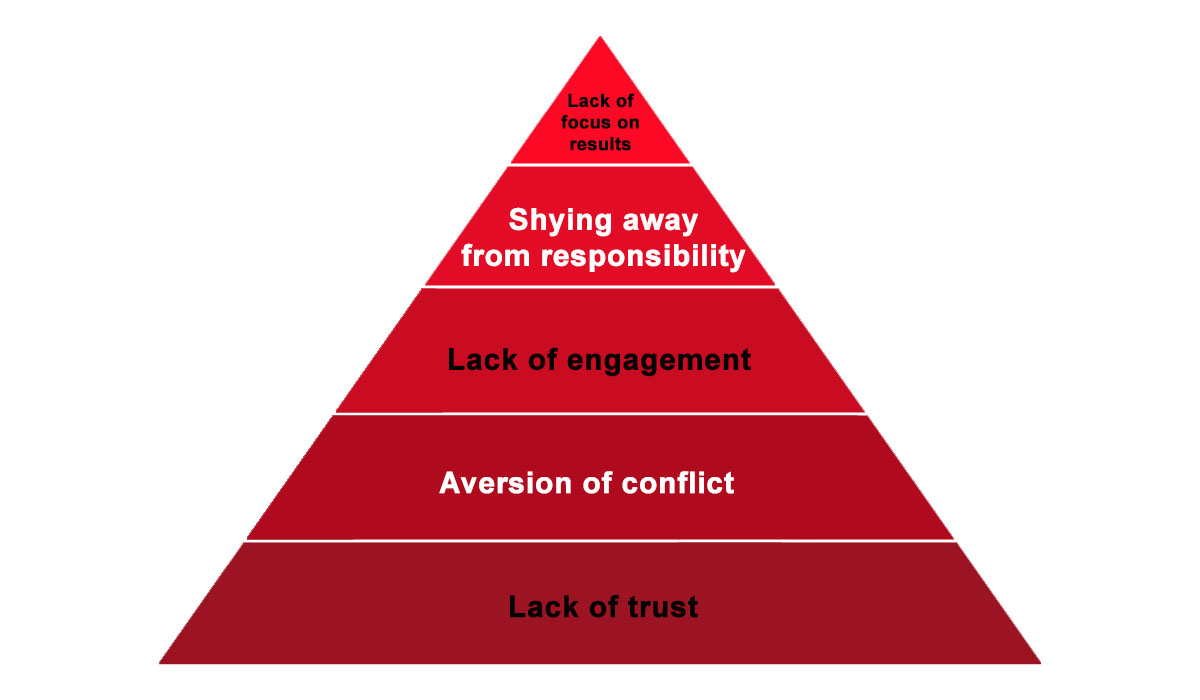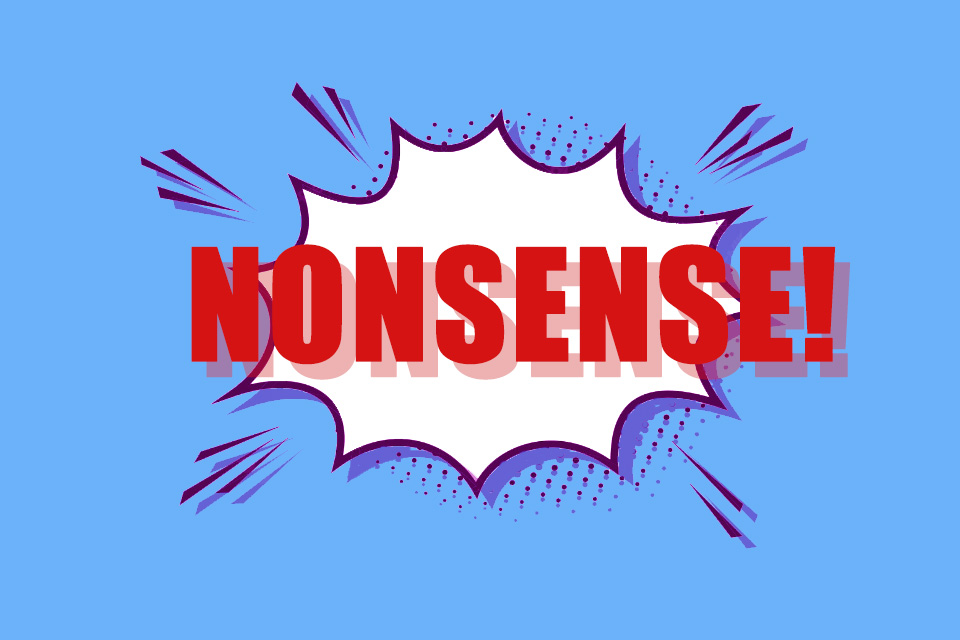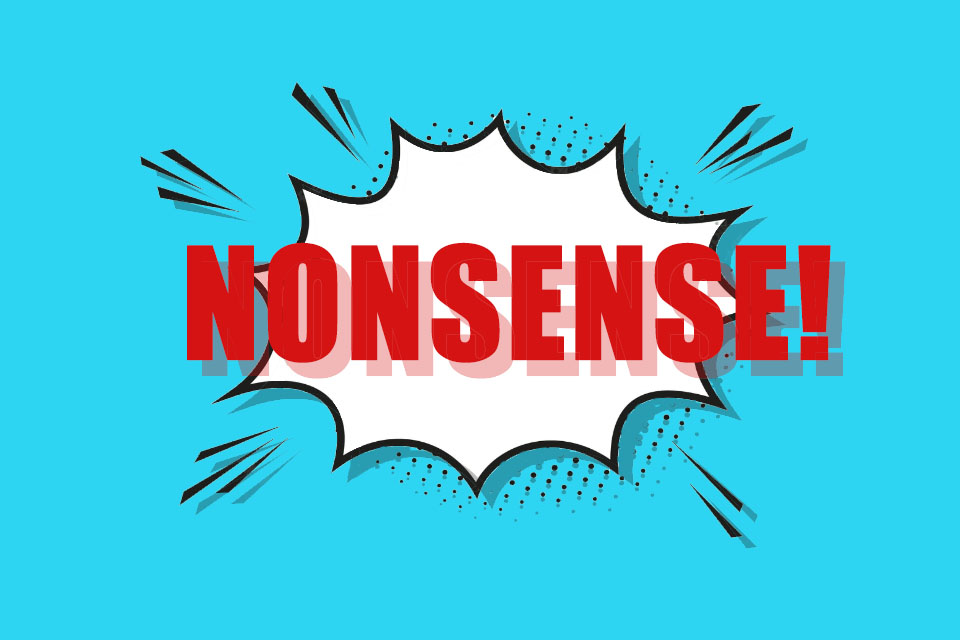Lencioni’s dysfunctions are toxic – what nonsense!
Never before have a few tweets made me re-read a book, even several times, so as not to miss anything.
- “one of the most toxic books ever”
- “one of the most harmful books I know”
I just didn’t want to believe that, because for me, a self-confessed radical pragmatist, it contained a nice basic pattern for team development that I could work well with.
What did I find in the review?
The story in Lencioni’s book
First of all, I was surprised to discover that the book belongs to the category of “business fiction”. Patrick Lencioni describes in a beautifully readable story how a group of soloists becomes a team and what hurdles it has to overcome along the way. This had completely slipped my mind, I only had his pyramid with the 5 dysfunctions in mind.
An even bigger surprise was when I realised what kind of team it is. It is not the usual team of developers, but the management of an IT company that is on the verge of insolvency and is therefore presented with a new managing director by the board. Kathryn, a manager from outside the industry, who is brought back from retirement. Her task: to turn the division heads, caught up in their silo structures, into a team of committed, results-oriented team players in a command and control world. Obviously, I had completely missed that.
She is not changing the corporate structure, nor is she using her power, as others probably would have done, to fire the “bad apples” from this round. She gives everyone the chance to understand the new challenge, change the behaviour, stay and go along with the new way of working together – or leave the organisation. This way of dealing with power reminds me strongly of TV series like “Welcome, Mrs. President!” or “Borgen” in which women act differently with and in power structures. Why Lencioni used a woman here – I’ll ask him.
Kathryn, in any case, relies on listening, understanding, arguing and convincing. Kathryn acts like a clever coach [The manager as coach – is that possible?], puts her finger in the wound again and again and asks the right questions so that the department heads have to question their own behavior again and again. Her only “demonstration of power” – she insists on the importance of her meetings and transformation workshops, the rest comes through the course of events.
What still excites me on rereading is the clarity and conciseness of the model, which helps to understand why a team often doesn’t perform as it could, why it fails in achieving certain goals.
For this, Managing Director Kathryn has a short and tangible introductory speech that she likes to repeat often: “We have a more experienced and talented management team than any of our competitors. We have more financial resources at our disposal. Thanks to Martin and his team, we have the best technical conditions. And we have the most powerful board. And despite all this, we are currently lagging behind two of our competitors. Can any of you tell me why that is?”
The response is silence.
“After having conversations with all the board members, spending time with each of you and also talking to most of the staff in our house, it is fully clear to me where our problem lies: We are not functioning as a team. In fact, to be more precise, we are quite dysfunctional.” [Lencioni, p.41]
Lencioni’s dysfunctions in detail
For Lencioni, there are five levels of this dysfunctionality: lack of trust in the team, fear of conflict, lack of commitment, reluctance to take responsibility and lack of results orientation. They build on each other, one does not work without the previous and it all starts with trust in the team. Lencioni paints this as a pyramid:
What do the disruptions mean in detail?
Deficit needs in the team
1. Lack of trust
Having an atmosphere of trust in the team means that you can open up, talk about doubts and uncertainties, about mistakes and risks. That you can have bad days. That you can argue without it being taken personally. Basically, it means the safe feeling that none of what others know about you will be used to your disadvantage. There are no interpersonal risks.
If this basic trust is missing, then no one will stick their head out and take a stand.
Today we call this “psychological security”. Incidentally, this is also the criterion that the Google employees named in their Aristotle study as the basic prerequisite for team development, without which everything else will not work.
To work on this, to establish trust, closeness and openness are needed. The suggestions Lencioni makes to achieve this go very much in the direction of the “Owner’s Manual for You!”, a great approach for a team kickoff, team development session or culture improvement workshop.
2. Shyness about conflict
This shyness is the logical consequence of a lack of trust. Why should I participate in a discussion if this is chalked up to “taking sides” afterwards and I may even be at a disadvantage as a result? Put the other way round: Only when I am sure that nothing will happen to me do I enter into discussions.
What is also needed to overcome the fear of conflict are language patterns and agreements on how contentious issues can be discussed and ultimately decided in such a way that everyone involved feels comfortable with the outcome and the way to get there. We are talking about establishing an appropriate culture of dispute, about rules of communication.
And here comes my only criticism of the book: Kathryn excessively celebrates the argumentation pattern “Yes, but…”. Even when she deliberately tries to avoid it once, it follows in the next sentence. [Lencioni, p.74] An absolutely counterproductive speech pattern. The popular saying is that everything before the”‘but” is a lie. At least it is often perceived that way.
If you want to know which language patterns really help, I would like to recommend David Marquet’s book “Leadership is Language”, for me the language bible for all those who are interested in how best to deal with differences of opinion and come to good decisions together with others.
So, there we have the two necessary conditions for good cooperation. If these two levels are dysfunctional, the atmosphere becomes toxic. This makes people sick and passive, leads to “working to rule” in the minimal version, to inner emigration and even to the search for a better working environment.
If you want, these two levels can be compared with Maslow’s concept of deficit needs, here in a team. The next three [dys-]functionalities would then correspond to Maslow’s growth needs.
Growth needs in a team
Positively formulated, next we need commitment from everyone in the team to the team goals, then a willingness to take personal responsibility for them, and finally a clear focus on results. In this order, one is again the prerequisite for the next. [Without the first two points, commitment only arises in broad-shouldered soloists with a strong desire to distinguish themselves].
3. Lack of commitment
Lencioni sees two causes for the lack of commitment:
- The desire for consensus and
- the need for certainty.
Both are certainty criteria to avoid making mistakes: How do we make a right decision? What if not everyone agrees? What if the outcome is uncertain? What to do if it turns out that the decision was wrong?…
Commitment, on the other hand, for Lencioni comes from a combination of clear decisions and everyone agreeing with the decision, even – and this is very important – if some took a different position at the beginning. The secret is not blind loyalty, but acceptance of the rules of the decision-making process, which includes being listened to at length and having a factual discussion. We are back to the culture of debate.
4. Shying away from responsibility
Now it gets really exciting, because this dysfunction does not refer to the responsibility one takes for the results of one’s own work. If you don’t want to do that, you are simply out of place.
It is about the responsibility one feels and perceives for the results of the work of everyone else in the team, for the team result as a whole. Lencioni uses a formulation here that made me gulp at first. He talks about “holding others accountable” at the level of silo heads, which is what his book is about and sounds no less invasive [The Table Group/Website].
What he is calling for here is nothing other than that the management team of a company that expects high performance from the teams “further down” must themselves be a high-performance team.
And now, dear reader, let’s sit back for a moment and go through in our minds how the cooperation at the levels above us in the company or in the companies that we advise takes place.
To interfere in the areas of the others, to feel responsible for solving the problems of the others in the team as a normality, as a natural expression of team spirit, that is the prerequisite for remedying the last dysfunction.
5. Lack of results orientation
Again, as in the previous point, this dysfunction does not mean not pursuing goals at all, but goals other than the team goals. In the original it means: “The pursuit of individual goals and personal status erodes the team’s focus on collective success.” [The Table Group/Website]. Does that sound familiar to you?
And here Kathryn comes around the corner with a rather crass question: “What I would like to know is whether you find this team here as important as the teams you yourself lead, your own departments! … I mean, who do you all consider your first team?”
This leads to an exciting, insight-generating discussion.
Changing the system of bonuses so that the team goal counts more than the silo goals would be a simple but certainly not very helpful method, because without the other preconditions this is likely to generate resistance rather than insightful action. And for Lencioni, the team goals here clearly go beyond what could be measured in terms of number of units, sales, turnover and profit.
Where are the limits of the book?
Patrick Lencioni draws the dysfunctions in the form of a pyramid, which gives the impression of a mechanical and discrete structure. It certainly doesn’t work that exclusively. [This is, after all, the criticism of Maslow’s hierarchy of needs, which, by the way, he himself never depicted as a pyramid].
Working on the first two dysfunctions goes hand in hand, you can’t do a workshop on openness and closeness without also starting to talk to each other in a more appreciative way. The moment I start to get involved, the question automatically arises of what for and also where the others are running to at the time! Intervening in the business of others to find solutions to their problems inevitably leads to the discussion of how the individual performances contribute to the team goal.
The dysfunctions of a team become most visible at the end, when nothing comes out of all the work. The starting point is psychological safety. And then, for the analysis, you can look at where the development got stuck.
What Lencioni does not describe are the parameters that led to the disastrous situation in the management and how they should have been changed. That would probably have gone beyond the scope of his story and was not his topic. What is interesting is that the team in the story sets out to change its previous structures and cooperation boundaries step by step on its own. Mission accomplished!
One note: Lencioni wrote the book in 2002, a good 20 years ago. At that time, there was not yet much talk about “agility” and “self-developing teams”. In 2014, Jeff Sutherland’s book “Scrum – The Art of Doing Twice the Work in Half the Time” was published about the framework he had developed together with Ken Schwaber 20 years earlier, in 1994. “Dysfunctions” is therefore a pretty old book for our fast-moving times. We can only find out whether a model is old or even outdated if we start to find the spirit of the model behind the letters, behind the language patterns of “superiors and subordinates”.
In general, the following should apply to older texts: What was the basic idea, does any of it still fit today and how could it be implemented? Incidentally, this also applies to the practical guide that Lencioni wrote as a supplement.
One last point: there is also no empirically verified, scientific double-blind study behind the dysfunctions. True, as with many other models, this is lacking. It is condensed experiential knowledge that matches the experiences and analyses of many others. Dig into your own experiences with teams and disruption – what of these applies, what would you work on, what would help?
It’s a checklist to look for working points if the team is not performing. That doesn’t mean that these have to be the only possible failures. Poorly set up Scrum, with interventions from the hierarchy, has its own effect.
Conclusion
Patrick Lencioni’s book “Dysfunctions” provides guidance on how to improve team cohesion together. A small checklist is in the book, a more detailed offer can be found on Lencioni’s website “The Table Group”.
In combination with new ways of thinking and tools, such as Liberating Structures or Delegation Poker”, many exciting possibilities arise. What if you combine Lencioni’s [dys-]functions with Tuckman’s approach to team phases and compare the respective necessary leadership styles with your own “natural leadership style”. Now it gets really interesting, doesn’t it?
I found a lot of good advice for agile coaches, project managers, product owners, scrum masters & Co. so that the people in the new world of collaboration can interact with each other in a suitable way and the structures in the house also enable this unfolding, as specialists for organisational development and communication.
But “one of the most toxic books ever” and “one of the most harmful books I know”?
What nonsense!
Notes (partly in German):
If you like the post or want to discuss it, feel free to share it in your network.
Patrick Lencioni, Die 5 Dysfunktionen eines Teams, Wiley-VCH-Verlag, 2014
Patrick Lencioni, Die 5 Dysfunktionen eines Teams überwinden. Ein Wegweiser für die Praxis, Wiley-VCH-Verlag, 2020
The Table Group
David Marquet, Leadership is Language, Penguin Business, 2020
Bedienungsanleitung für Dich
The Surprising Power of Liberating Structures, H. Lipmanowitz & Keith McCandless, Liberating Structures Press, 2013
TV series:
Welcome, Mrs. President/ Commander in Chief [USA, 2005],
Borgen – Gefährliche Seilschaften [DK, 2010-13]
We are also happy to recommend the Communication.Cards by Conrad Giller. They help to playfully change ingrained language patterns in order to better shape discussions. It is about thoughtlessly used stereotypes, about shaping relationships, about helpful feedback and about decision making and decision communication.
The offer is complemented by the new Columbo.Cards. Many differentiated tips combined with useful video material – definitely a good tip.
Conrad Giller has published other articles on the t2informatik Blog, including:

Conrad Giller
Conrad Giller has been working for about 30 years as a trainer, coach and consultant for almost all challenges of oral communication: conflict, team, leadership, storytelling, presenting, moderating, media, etc. He is happy to pass on his experience online and offline in workshops.




